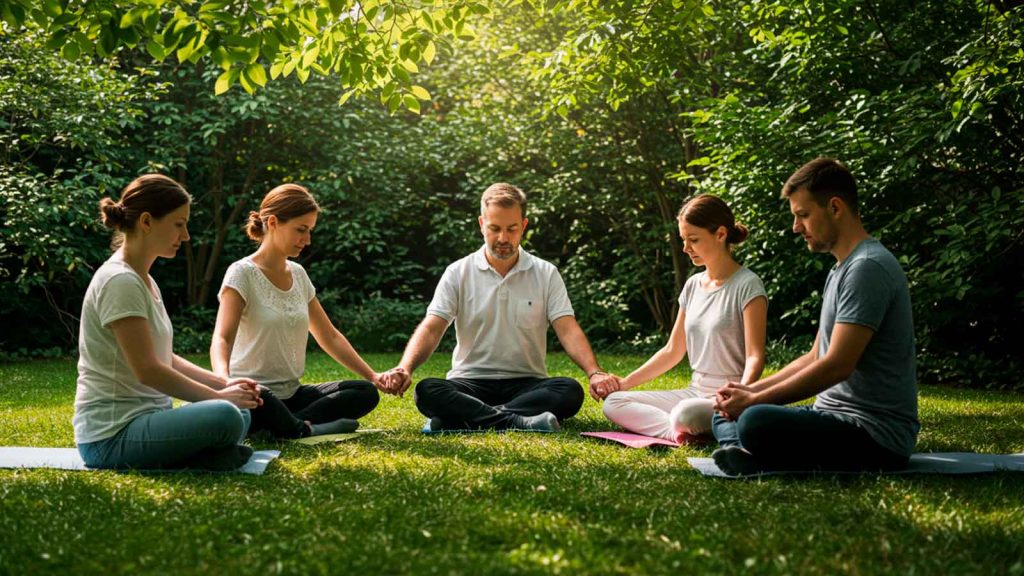The Power of the Calming Prayer
We live in a world full of pressure, demands, and daily challenges. That is why the calming prayer arises as an essential tool for those seeking moments of serenity—even in the midst of chaos. More than words spoken into the wind, it is an invitation to quiet the mind, open the heart, and draw strength from something greater.
The calming prayer connects us to feelings of peace, hope, and confidence. Whatever your beliefs, setting aside a few minutes a day to pray can completely transform the way you deal with stress and anxiety.
Inspiring Calming Prayer Models
Prayer to Calm a Restless Heart
“Lord, my heart is unsettled. My mind won’t stop; my thoughts race. I ask that Your peace surround me, that I find serenity in Your love, and that I can breathe deeply and trust. Amen.”
Prayer to Calm in Difficult Situations
“Father, in the face of the challenges I face today, I ask for Your presence. Help me to remain calm, to act wisely, and not to lose faith. I know that with Your help I can face anything. Amen.”
Prayer to Calm Before Sleeping
“Beloved God, I thank You for this day. I place all my worries in Your hands and ask that You calm my mind and heart so I may have a peaceful night. May I wake up renewed and ready for a new day. Amen.”

Why Pray a Calming Prayer
Emotional Relief
Many times, we carry burdens heavier than we can bear. Saying a calming prayer allows us to unload these tensions—surrendering what we cannot control and strengthening ourselves within.
Mental Clarity
When we’re under pressure, our mind can become clouded, unable to see solutions. The calming prayer helps organize thoughts, bringing clarity and calm so you can make more conscious decisions.
Renewed Hope
The calming prayer is also an act of hope. It reminds us there is always a new chance, a new opportunity, and that—even in difficulties—we are not alone.
How to Practice the Calming Prayer in Daily Life
Create a Peaceful Space
Choose a quiet place where you feel comfortable. It might be a special corner at home, a garden, or even your bedroom. This will be the setting for your calming prayer.
Use Sincere Words
There is no magic formula. The most important element of a calming prayer is sincerity. Speak from the heart—even if it is simply to say you are tired, anxious, or sad.
Take Deep Breaths
Before starting your calming prayer, inhale and exhale deeply a few times. This helps prepare both body and mind for the moment of prayer.

When to Turn to a Calming Prayer
Before Important Meetings
Reducing Anxiety in Advance
A calming prayer said before a meeting, presentation, or interview helps ease the nerves that often arise. As you pray, you organize your thoughts, reduce agitation, and find inner confidence to handle the situation.
Staying Calm in the Crucial Moment
You can also say a short silent prayer just before stepping in. It helps maintain emotional balance, prevents mental blocks, and projects a more confident demeanor.
During Moments of Conflict
Stopping Impulsive Reactions
In the midst of conflict, a calming prayer serves as a reminder to pause, breathe, and reflect before reacting. This prevents hasty responses and allows for a more peaceful and constructive approach.
Healing Emotions After Conflict
Even after the argument ends, feelings of anger or sadness may linger. At that moment, prayer acts like an emotional balm, helping process what happened and restore inner peace.
Amid Everyday Worries
Handling Daily Irritations
Traffic, long lines, delays, or tasks that don’t go as planned: small annoyances build up emotional tension. A brief calming prayer helps you stay balanced, preventing stress from accumulating throughout the day.
Finding Peace in Small Pauses
You can use simple moments—like a coffee break or a pause between tasks—to silently pray. These small pauses restore energy and keep your mind serene.
In Times of Excessive Self-Criticism
Silencing the Negative Inner Voice
When thoughts of self-criticism arise—such as “I’m not good enough” or “I never do anything right”—the calming prayer breaks that mental cycle. It brings compassion and self-awareness, allowing you to see your flaws more kindly.
Reinforcing Personal Confidence
Prayer also reminds you that you are constantly learning and that every mistake is an opportunity for growth. As you pray, you strengthen self-confidence and find courage to move forward.
When Facing Unexpected Changes
Accepting What We Cannot Control
Changes—such as a new job, unexpected news, or moving to a new city—can bring insecurity. The calming prayer helps you accept the situation, understand that some things are beyond your control, and maintain serenity amid the new.
Seeking Strength to Face the Unknown
Beyond acceptance, prayer strengthens emotionally. It reminds us that we can face challenges—even when the future seems uncertain—and that we can always trust our ability to adapt.

The Calming Prayer and Inner Growth
Developing Patience
Praying regularly helps cultivate patience. The constant practice of the calming prayer teaches us to wait with confidence rather than despair.
Nurturing Confidence
Over time, the calming prayer strengthens our confidence— not only in a divine power, but also in ourselves and in life.
Bringing Perspective
In difficult times, it’s easy to lose perspective. The calming prayer helps us remember what truly matters and put problems in their proper place.
How to Teach the Calming Prayer to Children
Use Stories and Images
For children, the calming prayer can be introduced in a playful way—using stories, images, or songs that convey tranquility.
Make It a Routine
Set a fixed time of day to pray with the child—perhaps before meals or at bedtime. This helps create a healthy habit.
Encourage Creativity
Allow the child to create their own words in the calming prayer. This makes the moment even more meaningful and personal for them.
How to Strengthen Your Calming Prayer Practice
Use a Prayer Journal
Writing down your feelings, requests, and gratitude after each calming prayer helps you reflect on your emotional and spiritual journey.
Find a Prayer Group
Joining groups that practice the calming prayer can provide support and strengthen your faith and perseverance.
Combine with Soothing Music
Listening to calm music before or during your calming prayer can help silence the mind and open space for inner peace.
Common Mistakes When Saying a Calming Prayer
Turning It into an Obligation
When Prayer Becomes Just Another Task
One of the most frequent mistakes is treating the calming prayer as just another item on the daily to-do list. When that happens, it loses its power to touch the heart because it turns into something automatic, without real engagement. The danger is transforming prayer into a cold obligation rather than a genuine moment of connection.
How to Avoid This Mistake
Remember why you pray. Reflect on the reasons that lead you to seek calm and serenity. Return to the original purpose: to create space for peace, not just fulfill a ritual. Keep your heart open, even if the prayer is short.
Rushing the Moment
The Effect of a Prayer Said in Haste
Modern routines leave us little time, and often we try to squeeze the calming prayer into a tight slot. The problem is that a rushed prayer, said only to “tick the box,” rarely produces the desired effects. It’s like taking a quick sip of water and expecting to fully quench your thirst.
How to Devote the Right Time
Set aside an appropriate moment to pray. Even if it’s only five minutes, dedicate that time exclusively to prayer. Turn off your phone, switch off the TV, close your eyes, and allow yourself to fully immerse in the moment. Remember: quality of time matters more than quantity.
Expecting Immediate Results
The Expectation of Quick Change
Another common mistake is expecting the calming prayer to solve everything instantly. You pray today and want to feel completely calm tomorrow. However, prayer is not a magic button that erases difficult emotions right away.
How to Cultivate Patience in the Process
Inner transformation takes time. Every prayer planted in the heart is like a seed—it needs care, watering, and patience to flourish. As days pass, you’ll start to notice small changes: more serenity, more confidence, more clarity. Don’t be discouraged if results aren’t immediate; trust the process.
Repeating Words Without Emotional Connection
The Danger of Empty Words
A subtler yet common mistake is reciting memorized words without emotionally connecting to them. When the calming prayer becomes just a set of phrases mechanically repeated, it loses part of its impact.
How to Make Prayer More Authentic
Be spontaneous. If you feel like using your own words, do it. If you prefer a well-known prayer, that’s fine—but while reciting it, try to experience each word, thinking about what it means to you. The secret lies in praying with truth.
Giving Up When You Don’t See Improvement
The Temptation to Abandon the Practice
Sometimes, after praying for a few days, you may feel that nothing has changed and that the calming prayer isn’t working. Many people quit the practice before it has a chance to take real effect.
How to Maintain Perseverance
Understand that prayer is an ongoing journey. The calm you seek may come gradually, subtly. Even when it seems there’s no answer, continue. Often, the greatest changes happen imperceptibly, slowly transforming the way you face challenges.
Calming Prayer FAQ
Do I need a specific religion to say the calming prayer?
No. The calming prayer is accessible to everyone, regardless of religion. The most important element is sincere intention.
How many times a day should I say the calming prayer?
That depends on each person. Some prefer to pray once a day, while others like to repeat it several times throughout the day.
What if I don’t know what to say in the calming prayer?
That’s okay. You can simply keep silent, breathe deeply, and ask for mental peace. Sometimes, silence itself is a powerful prayer.
Can I use a prayer written by someone else?
Yes, you may use ready-made prayers if they resonate with you. The essential point is that the words touch your heart.
Is there an ideal age to teach children the calming prayer?
The earlier, the better. Young children learn easily and can naturally incorporate this practice into their daily routine.
READ ALSO:
- Psalm 76: Deep Reflections and Meanings
- Psalm 75: Acknowledging Divine Justice and God’s Power
- Psalm 74: Reflections on Divine Presence in Times of Crisis
FOLLOW US ON FACEBOOK
We hope you enjoyed this article.